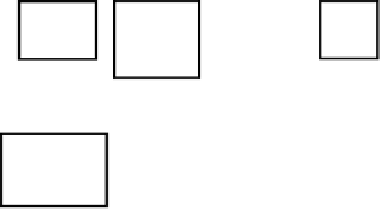Image Processing Reference
In-Depth Information
Power
FBC
freq
-fs
-fs
/2
0
+
fs
/2
+fs
Power
(b) spectrum of forward modulation
freq
Power
-fs
-fs
/2
0
+
fs
/2
+fs
(a) spectrum of IQ-input
RBC
freq
0
-fs
-fs
/2
+
fs
/2
+fs
(c) spectrum of reverse modulation
Power
LPF1(z)
Power
freq
0
-fs
-fs
/2
+
fs
/2
+fs
BPF2(z)
B
PF1(z)
2・
FB
freq
(d) spectrum of complex LPF1
0
Power
-fs
-fs
/2
+
fs
/2
+fs
LPF2(z)
RB
C
FB
C
freq
(f) spectrum of demodulation
-fs
-fs
/2
0
+
fs
/2
+fs
2・
RB
(e) spectrum of complex LPF2
Fig. 15. Frequency design of the modulation/demodulation system
4.3.2 The FFT/IFFT system
The block diagram of the FFT/IFFT system is shown in Fig. 16. Two sets of filters
corresponding to the baseline-shift separate the IQ-signal after FFT processing. These filters
are realized by applying
WR
with the characteristics of
FB
,
RB
,
FBC
, and
RBC
shown in Table 6. Next, the separated spectra are returned to the time domain signals
by inverse-FFT. Since the frequency range expands on the basis of the baseline-shift, we
perform twice-point inverse-FFT. Further shift in time waveform after inverse-FFT is carried
out, and a continuous output is obtained. The power spectrum of the IQ-signal after FFT is
shown in Fig. 17(a). When the baseline-shift is terminated, the spectrum in the figure
(equivalent to the aliasing (A) in Fig. 12) is observed on the negative-side. However, by
operating the read-out address of FFT, the positive display range is expanded and observed
on the positive-side. Similarly, by carrying out inverse-FFT processing with
WF
and
WF
and
WR
with a frequency twice that of sampling ( 2
f
), the frequency range of the Doppler
Forward
Signal
FD Filter
WF(ω)
WR(ω)
Shift
Adder
Complex
FFT
Complex
IFFT
IQ-Input
fs
2・
fs
Reverse
Signal
Complex
IFFT
Shift
Adder
Band Width
Center Freq
Table
BLS
2・
fs
Fig. 16. Block diagram of the FFT/IFFT system










































































































































































